- HubPages»
- Education and Science»
- Life Sciences»
- Paleontology
The Beasts after the Dinosaurs
The first mammals evolved from therapsids ("mammal-like reptiles") at the end of the Triassic period, and co-existed with the dinosaurs throughout the Mesozoic Era. However, it was only after the dinosaurs became extinct that the mammals were able to evolve beyond their tiny, mouselike forms into larger creatures.

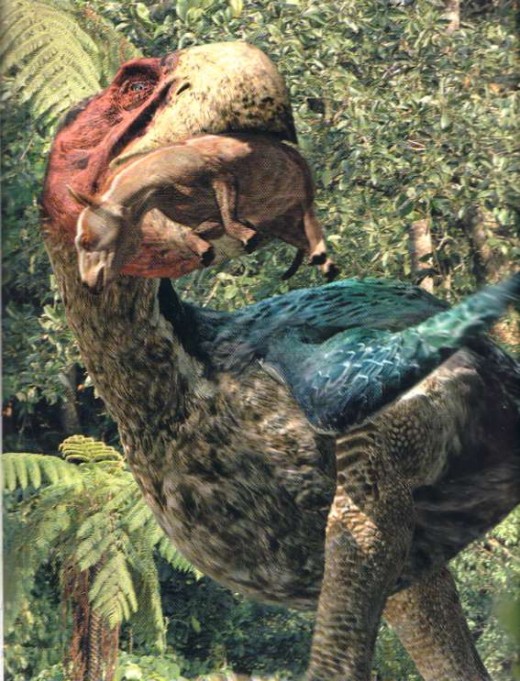
Gastornis (56-41 mya)
Size: 1.76–3.08 meters (5.87–10.27 feet) tall, and about 400 lbs (181.4kg).
Place and epoch: The woodlands of Western Europe and North America during the Paleocene and early Eocene epochs.
The Gastornis, also known as the Diatryma, has been questioned and debated about whether it was a herbivore, carnivore or even an omnivore.
This creature probably wasn't the biggest prehistoric bird to have ever lived, but it my have been the most dangerous. It had a tyrannosaur-like profile with powerful legs and small arms. Some theories state that Gastonis hunted in packs, and others that it may not have been a predator at all, but a plant eater which used its powerful jaws to crush tough vegetation.
Ambulocetus (50-49 mya)
Size: 3 meters (9.8 feet) long and 1 meter (3.3 feet) tall, and about 500 lbs (227kg).
Place and epoch: Germany, during the Eocene epoch.
The Ambulocetus was extremely agile in the water and hunted by ambush, but awkward on land. They look a lot like crocodiles, but are actually the ancestor of whales, sharing the same swimming style.
They hunted by ambush, putting their jaws to the ground and detecting vibration. Their vise-like jaws held the prey until it drowned.
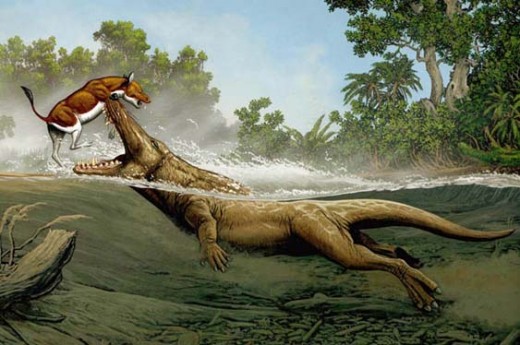
Andrewsarchus (60-32 mya)
Size: 5.5 meters (18 feet) and 2 meters tall (6.6 feet), and about 1,000 to 2,000 lbs (454 to 907 kg).
Place and epoch: Mongolia in the late Eocene epoch.
These beasts were heavily built -- they walked on four short legs and had a very long body, a long tail, long snout and large, sharp teeth. However, despite their appearances, they were not related to modern scavengers like dogs, wolves or hyenas. One weird feature is their hooves on their feet instead of claws. These creatures were the largest meat-eating land mammals to ever have lived on Earth.
Their nearest modern relatives are hoofed animals like sheep and goats as they were distantly related to modern dayungulates (hoofed mammals) and tocetaceans (whales and dolphins).
To explain the name, Roy Chapman Andrews discovered these creatures in the 1920s and named them after himself -- Andrewsarchus meaning "Andrew's beast".


As the Earth's climate changed, it revealed vast open plains which made way for smaller, but more vicious, predators. The plains also became home to the biggest-ever land mammals -- the mighty Indricotherium.
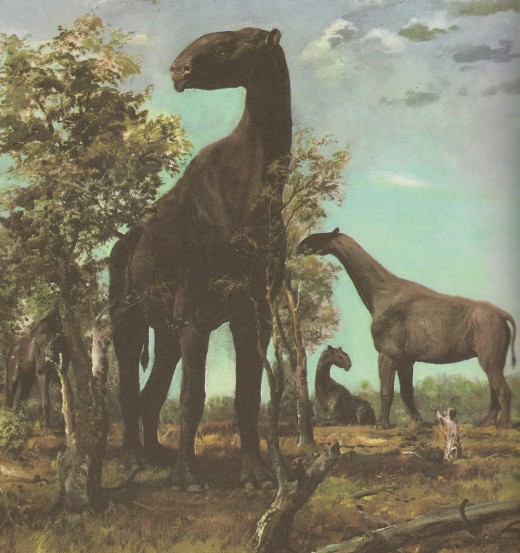
Indricotherium (30-25 mya)
Size: 7 meters (23 feet) tall and 8 meters (26.2 feet) long, and about 15-20 tonnes (33,000 - 44,000 lbs) in weight.
Place and epoch: The plains of Asia in the Oligocene epoch.
This beast was hands down, the largest terrestrial mammal to have ever lived, approaching the size of the sauropod dinosaurs that preceded it by over a hundred million years. An ancestor of the modern rhinoceros, it had thin, long legs with three-toed feet and a long neck.
Fossils of the herbivore have only been found in the central and eastern parts of Eurasia, but it is possible that the Indricotherium resided across the plains of western Europe and other continents.
Other names for the Indricotherium include Paraceratherium and Baluchitherium.

Entelodont (45-25 mya)
Size: 2 meters (6.6 feet) long and 1.8 meters (5.9 feet) tall, and about 2000 lbs (900 kg).
Place and epoch: The plains of North America, Europe, and Asia from the middle Eocene to early Miocene epochs.
The Entelodont, known as the bullies of the plains, were distant relatives of the pig, wathog and wild boar. They were aggressive and loved to pick fights, but were not very clever. Many smaller mammals lived in fear of these creatures, even scaring the massive Indricotherium.
They were both scavengers and hunters, eating whatever they could find as omnivores.
Hyaenodon (41-25 mya)
Size: Up to 5.5 meters (18 feet) long and 1.8 meters (5.9 feet) tall, and from 100 lbs to as much as 1100 lbs (45 to 500 kg).
Place and epoch: The plains of North America, Eurasia and Africa during the late Eocene and early Miocene epochs.
"Hyaenodon" translates into "hyena tooth" even though this animal is in no way related to any feliforms or modern carnivores. They were, however, much more dangerous. Their size can differentiate incredibly, as you can see from the size at the top.
It preyed on a group of animals called the Chalicotheres, newborn Indricotheres, bear-dogs and some Entelodonts. Their size and horrifying sharp teeth make them a deadly predator -- they have a shattering force of over 1,000 lbs per square inch. However, like most other ealy carnivorous mammals, they were not the brightest of animals.


By around 3 million years ago, animals are beginning to look more like the ones we see on Earth today!
Deinotherium (20-1.5 mya)
Size: 5 meters (16.4 feet) long and 4.5 meters (14.8 feet) tall, and about 5 to 10 tonnes (11,000 to 22,000 lbs).
Place and epoch: The woodlands of Africa and Eurasia during the middle Miocene to early Pleistocene epoch.
Deinotherium Giganteus actually means "Giant Terrible Beast", and these animals were indeed pretty giant (and aggressive). They were as tall as the modern giraffe and as heavy as two modern elephants, one of the largest non-dinosaur creatures to ever roam the earth. Some experts have speculated that these creatures inspired ancient tales of giants. Apart from its size, another notable feature of the Deinotherium was its short, downward-curving tusks -- so different to the usual elephant tusks that 19th century paleontologists reassembled them upside down. Apparently they used these tusks to strip bark from trees.
The Deinotherium were either hunted to extinction by early humans, or succumbed to changing climatic conditions.

Smilodon (2m - 10,000 ya)
Size: 2.5 meters (8.2 feet) long and 1.3 meters (4.3 feet) tall, and about 500 lbs (227 kg).
Place and epoch: The plains of North and South America, during the Pliocene epoch to the early Pleistocene epoch.
Let's set things straight -- although the Smilodon is referred to by most people as a saber-toothed tiger, this mammal was not a tiger at all. It instead belonged to an ancient, long extinct line of cat-like creatures known as "machairodonts".
This ferocious animal would have snacked on early humans as well as the woolly mammoths and giant sloths of the Pliocene and Pleistocene epochs. They would leap on their prey suddenly from the high tree branches and dig their huge incisors into the animal's neck. They would then withdraw to a safe distance while their dinner bled to death. It is unknown whether the Smilodon hunted in packs.
The last specimen of Smilodon went extinct only 10,000 years ago -- by then primitive humans had figured out how to hunt and kill off this menace.


Doedicurus (2m - 10,000 ya)
Size: 4 meters (13 feet) long and 1.5 meters (4.9 feet) tall, and up to two tonnes (4409 lbs).
Place and epoch: The swamps of South America, in the Pleistocene to early Holocene epoch.
The Doedicurus had a large, thick shell and a long tail with a spiked club on the end. As big as a family car, these relatives of modern armadillos were the most heavily armored mammals. Their spiked tail clubs alone could weigh 74 kilos (163 lbs) -- as much as a cannonball. They looked very similar to the ancient dinosaur Ankylosaurus, which were bigger and did not have spikes on their tails.
These mammals had no need to fear even the most ruthless hunters -- not even the Smilodon. Their enemies were other members of their species. The males mostly used their tails on each other to batter rivals into submission whilst fighting for a mate.
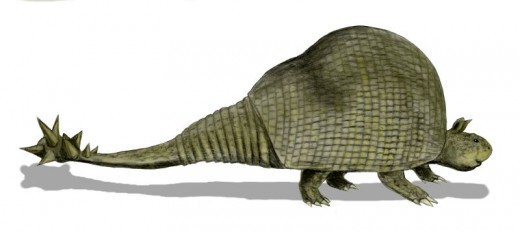

The world started growing colder from about 1.5 million to 10,000 years ago. Massive sheets of ice (sometimes several hundred meters thick) moved down from the north and cut their way across the land. To cope with this, many hairy animals evolved.
Megatherium (1.9m - 8,000 ya)
Size: 6 meters (19.7 feet) long, 4.5 meters (14.8 feet) tall, and about 2 to 3 tonnes (4409 to 6614 lbs).
Place and epoch: The woodlands of South America, during the late Pliocene to late Pleistocene epoch.
This prehistoric sloth was as big as an elephant. It was a well-built, slow-moving giant. Based on its huge claws, paleontologists believe that the Megatherium spent much of its time rearing up on its legs and ripping leaves off trees. Other experts like to think that this mammal may have been an opportunistic carnivore which slashed and killed it's fellow South American herbivores.
Ignoring the thick coat of fur, this mammal was very similar anatomically to a razor-clawed breed of dinosaurs known as the Therizinosaurs.

Woolly Mammoth (135,000 - 11,000 ya)
Size: 3.5 meters long (11.5 feet) and 3 meters (9.8 feet) tall, and about 5 to 7 tonnes (11,000 to 15,400 lbs).
Place and epoch: The plains of North America and Eurasia, during the late Pleistocene to early Holocene epochs.
Unlike the case with most dinosaurs, paleontologists know exactly what the Mammuthus primigenius (better known as the Woolly Mammoth) looked like, due to the discovery of complete specimens buries in Arctic permafrost.

This prehistoric elephant was about the size of modern elephants, but they were distinguished by the camel-like humps on their shoulders, long woolly hair and their enormous, curved tusks.
Unlike its leaf-eating relative, the Mammut (or Mastodon), the Woolly Mammoth grazed on grass like an enormous cow, sometimes eating up to 180 kilograms (397 lbs) per day. Because of various cave paintings, we now know that these mammoths were hunted to extinction by the prehistoric human settlers of Eurasia who would kill them for their shaggy coats, impressive horns and meat. However, a pygmy species of Mammuthus managed to survive until 4,000 BC on Wrangel Island in the Arctic Ocean.
Scientists think it may be possible to clone a Woolly Mammoth by scraping together enough preserved genetic material to constitute a genome, then implanting the fertilized egg in a female elephant.

Woolly Rhino (500,000 to 10,000 ya)
Size: 3 meters (9.8 feet) long and 2 meters (6.6 feet) tall, and about 3 tonnes (6,613 lbs) in weight.
Place and epoch: The plains of northern Eurasia, during the Pliocene to Pleistocene epoch.
The Woolly Rhino, also known as Ceolodonta, is one of the few megafauna Ice Age mammals to be depicted in cave paintings. It was drawn to extinction very much like the Woolly Mammoth -- by the early humans' hunting. It's thick fur pelt could clothe an entire village!
Aside from the thick fur, the Woolly Rhino was very similar to the modern rhinoceroses, which are its immediate descendants. However, its horns were much bigger -- a big, upward-curving horn on the tip of its snout and a smaller pair set further up nearer to its eyes. The Woolly Rhino not only used its horns to draw in potential mates, but to clear the Siberian snow away and munch on the underlying grass.
Also like their descendants, these rhinos were very short-sighted. They were easily startled and charged at anything that surprised them. When males fought, their fights were not always violent. They would mostly scrape their horns on the ground until one of them backed down and left the area to the victor.

Modern humans' early relatives were Australopithecus -- apes that walked on two legs. They were around about 4 million years ago. The Neanderthals evolved later, living 300,000 to 28,000 years ago. Homo sapiens first appeared around 100,000 years ago, and are still here today.
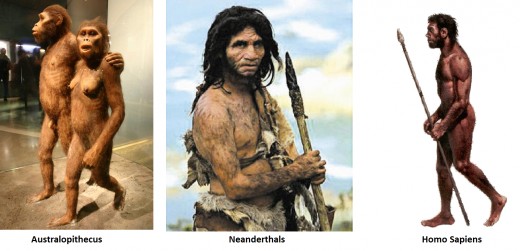
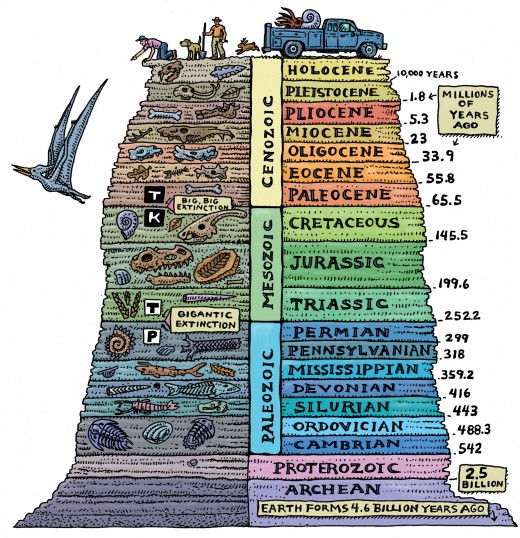
Sources and further links










